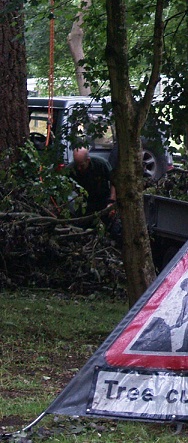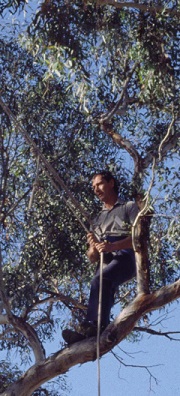CERTIFICATE IN ARBORICULTURE
This certificate focuses on the
culture and care of trees, providing a sound foundation for any working
or hoping to work with tree establishment or maintenance.

- Develop knowledge and skills needed to work in arboriculture
- Lay a foundation for lifelong learning in plant identification, selection and care
- Work in tree management -start a business, or get a job
- Start anytime; work where and when you want
- Study when your mind is sharp; and avoid wasting time and money traveling to a classroom
Unlike many other courses in arboriculture, this course also provides a broad foundation across all aspects of horticulture.
Work with trees the lungs of the world.
To work in the challenging and stimulating arboriculture industry you
need fundamental knowledge and understanding of trees, their amenity
value and their indisputable value to the environment. Such knowledge
includes the maintenance and management of trees; tree assessment for
health, monetary or environmental value, fundamentals of planting,
transplanting, pruning, site planning, identification and treatment of
pests diseases, nutritional and other disorders, tree surgery,
after-care and advice and tree removal.
Opportunities in this growing industry include employment in
private specialist contracting businesses, self-employment, local and
state government positions. Activities include the maintenance and care
of trees and large shrubs in private gardens, public parks, reserves,
bushland reserves, recreational areas, industrial complexes, housing
estates and institutions.
Use the link below ('read more') to view more comprehensive details on this course.
Arboriculture is the ‘culture’ and 'management' of trees. It concerns every aspect of growing trees, from selecting the right tree for the right place, to the care and maintenance of established trees.
Change the way you look at trees forever.
After this course, you will see problems in trees and know appropriate ways to respond, well before issues get out of hand. You will make better decisions more often, saving time, money and manpower; and bringing about better outcomes in the management of trees.
Modules
Note that each module in the CERTIFICATE IN ARBORICULTURE is a short course in its own right, and may be studied separately.
Tree Pruning and Lopping
Trees growing in their natural state manage to attain full size without the help of humans; however there are differences between trees in nature and tree in an artificial environment. For example, public access must be maintained, and branches cannot be allowed to just drop.
The main objectives are:
- To shape the young tree in way that it will develop a well balanced crown.
- To improve balance in a semi-mature tree.
- To remove dead and dangerous branches before they fall.
- To remove crossing branches to open up the inside of a crown and to reduce the likelihood of wounds through branches rubbing together.
- To thin the crown – this lessens wind resistance, allows more light and air in the centre, reduces demand on roots (desirable if roots have been damaged), renews growth, and lessens likelihood of branches dropping.
- Remove lower branches to improve access past or under the tree.
- Reduce overall size of the crown where the tree has outgrown its situation.
- Repair damage through fire, storm, etc.
- To promote flowering or fruiting.
Where to Cut
When you prune a tree you should do the following with each cut you make:
- Use sharp and clean tools. Your cut should be sharp, no tears!
- When removing a branch don't cut it only half off – take it right back to where the branch is joined to a more major branch. At this intersection, make your cut from the outer point of the bark ridge (ie. the fold/swelling of growth on the top or inside of the intersection between the two branches) to the outer point of the collar (i.e. the swollen section on the bottom of the intersection between the two branches).
- When dropping a heavy branch you should first cut about 18 inches above where you will make the final cut on the underside of the branch. Next cut about 6 inches further up the branch than this on the upper side.
- These two cuts allow you to remove the greater mass of the branch with minimal tearing. You can then make you final "clean" cut.
Why Remove a Tree?
Removing a tree is a big decision; not only because it is a costly and time consuming job; but it can also change the whole environment of the area around it. Places that were cool and shaded can become hot, sunny and exposed; wildlife may not have a home anymore, and plants that were protected from wind, frost and other extremes may no longer be protected.
Trees may still however be removed for any of the following reasons:
Safety
Some trees are more notorious than others for dropping branches. If a tree is badly affected by tree rots, it is more likely to fall over or drop branches. Trees above children's play areas, outdoor living areas or buildings may cause more serious damage if they fall. In these and other risky situations it may be valid to remove all or part of a tree.
Hygiene
Pests and diseases may build up in large numbers on a tree and from there spread to other plants.
Provide an Open Space
Trees are removed to provide space for building or construction work; or to provide an area where sun can enter a garden.
Minimise Maintenance
Trees can create shade keeping areas from drying out and creating difficulty growing lawn or other plants. Branches overhanging buildings may drop leaves in guttering, or rub on buildings when moved by wind. Excessive leaves on the ground in wet weather can create a slippery surface or smother smaller plants, requiring regular raking.
Damaging roots
Trees may be removed because roots cause damage foundations of buildings, block pipes and cause damage to paving walls and other structures.
Timber
Trees are sometimes removed as a source of timber, for construction, or fuel.
WILL THIS COURSE GET ME A JOB?
For a sustained business or career in tree management; you must above all be able to do the job. This is not an industry that requires high qualifications; but it does require a high level of expert knowledge. You must be able to identify hundreds of different tree species, understand the differences between each, and know how to manage each in an appropriate way for the place in which it is growing.
Most successful arborists will learn some of what they know through formal study, and some through on the job experience.
No course will guarantee you a job - but this course will go a long way toward helping you learn what you must know to be successful as an arborist.
This course may take longer than some certificates; but proper learning takes time.

Learn the Fundamentals first
A good arboriculture education should be broad. When you learn the basic fundamentals first (i.e. the core skills needed to work in the industry in general); other things make more sense and will be remembered better as you encounter them.
This course doesn't just teach you how to chop down trees; but also how to select them, plant them, the right soils, how to care for and maintain them, their pests and diseases, how to perform tree surgery and lastly how to cut them down safely if needed. Learning the basic cultural requirements for trees means that you have more scope should you want to move across jobs (for instance you may work for an arborist but decide that you would like to work in public gardens in tree care - this course would enable you to do that).
Retaining knowledge
There is little point studying a shorter course, passing an exam, then forgetting what you studied. Most of us however will only store knowledge in short term memory, unless you keep revisiting that information. This is the ‘use it or lose it scenario’.
As educators we have found at ACS that the best way to properly learn, is to encounter core ideas about arboriculture periodically throughout the course, in different contexts. We set you problems to solve, research or practical set tasks, rather than just reading and regurgitating facts and figures from text books. You are prompted to rethink what you studied earlier and use that information in different ways, as you progress.
Recalling what you have learned
There is a difference between retaining what you have learned to short term memory and recalling what you have learned years later. Undertaking problem solving tasks and projects are much more likely way to commit information to long term memory. We consider that, along with a passion for what they are studying, to be the key reason our students do so well in their courses, our courses are based on a Problem Based Learning system. Problem based assignments and practical set tasks mean that students have to work at finding solutions and developing skills. These may come from various sources - in the process they gather knowledge through experiential learning, which is more likely to be retained in long term memory.
So although a course and qualification won’t necessarily get you a job – choosing the right course and learning the right things will certainly help.
Opportunities for Graduates
- Manage your own Tree management business
- Get a job such arborist, tree lopper, groundsman, forester or gardener
- Work in marketing or supply of arboriculture equipment (e.g. machinery, climbing equipment)
- Start a tree nursery
- Be a tree planting or pruning contractor
- Become a consultant, teacher or writer to advise others on tree management
ENROL or Use our FREE Course Advice Service to Connect with a Tutor